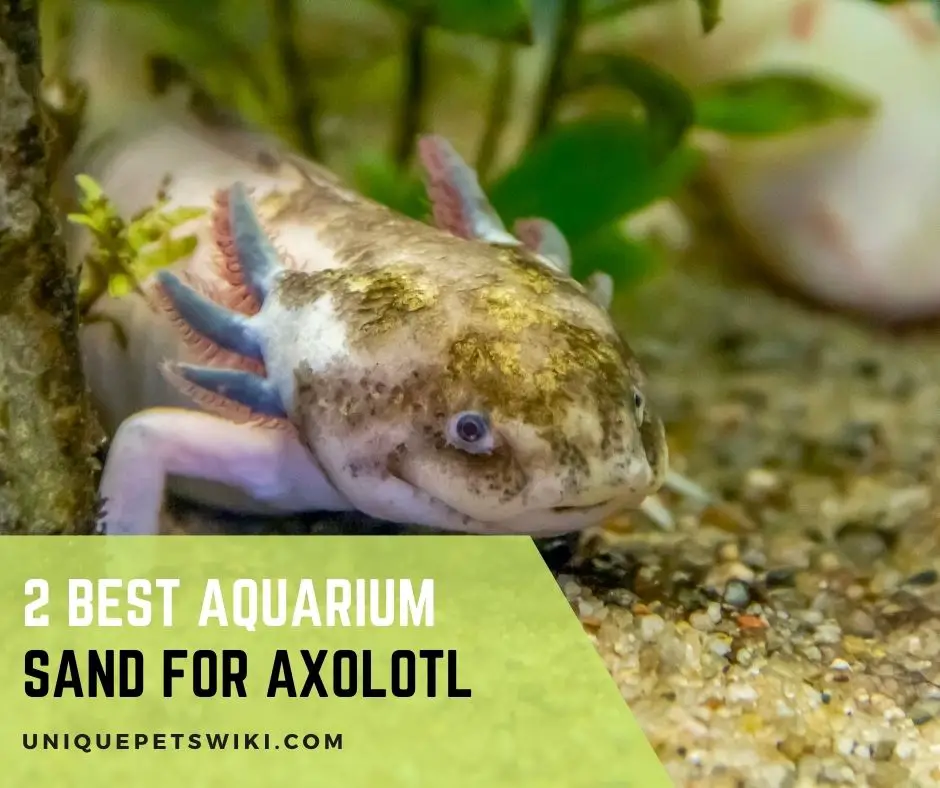From water chemistry to filtration to aesthetics, in an axolotl’s aquarium, a substrate is extremely crucial.
Preparing an axolotl tank necessitates paying closer attention to the substrate; you might overlook while setting up your tank.
When setting up an axolotl tank, one of the first considerations should be the substrate.
Perhaps you’re unclear whether or not a sand substrate will benefit them, which sand products are the best, and more!
After reading this post, you’ll understand the advantages of using aquarium sand for axolotl as a substrate, our top two picks, and why.
Contents
Benefits of Using Sand for Axolotl
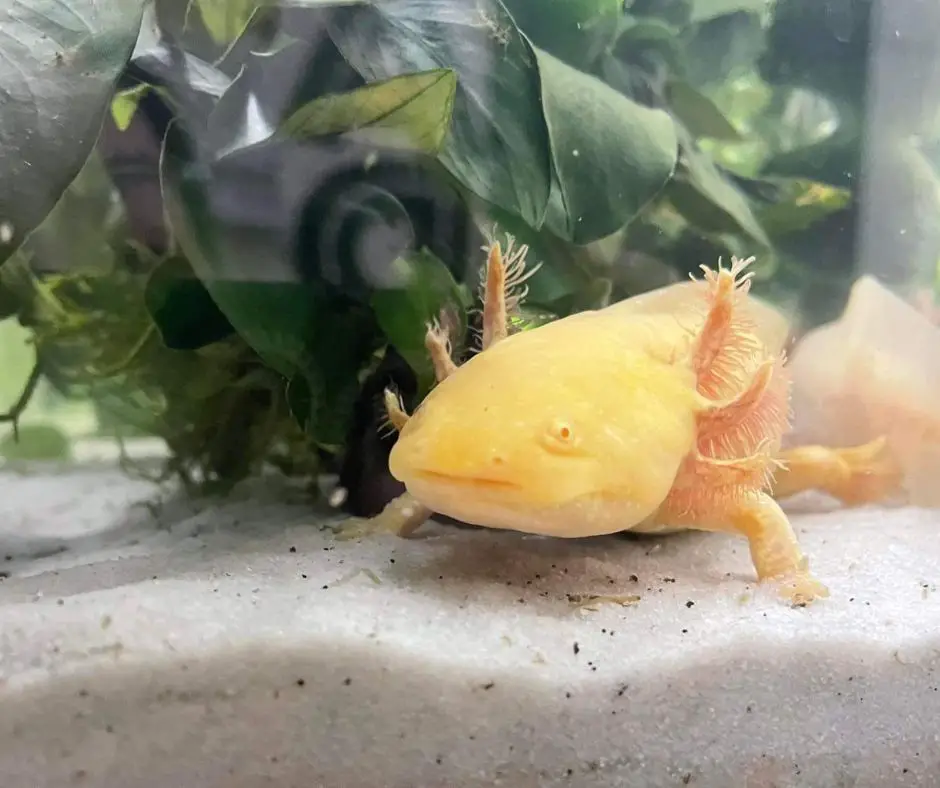
Sand is an excellent substrate for your Axolotl for a variety of reasons. To begin with, sand substrates are gentle on your axolotl’s feet, whereas rough or slick surfaces will cause stress and possible injury.
Secondly, sand enhances the looks of your Axoltol’s tank greatly.
Additionally, unlike gravel substrate, if an Axolotl accidentally consumes gravel, it might result in stomach blockage, resulting in death.
Furthermore, It also keeps your tank clean and balanced because of its natural bacteria and water filtration properties.
Did you know that these salamanders aren’t particularly fond of light and that reflections on the tank floor’s bare glass might cause them stress?
But using sand as your substrate can cover the bottom of the tank, reducing light reflections.
Finally, because a sand substrate is already good for your aquarium in the long run, it saves you money.
Please keep in mind that the aquarium sand axolotl substrate is only safe for adult axolotls; it is not safe for juvenile axolotls.
Buyer’s Guide: What to Look for in Good Sand For Axolotl?
For axolotl tanks, sand is generally recommended as the ideal substrate. Choosing the appropriate sand can also help keep your axolotl healthy while in captivity.
There are four primary factors to consider when choosing sand as a substrate for your Axolotl.
It should be secure, natural, easy to clean, and competitively priced. Below, we’ll go through each of those four characteristics in further detail.
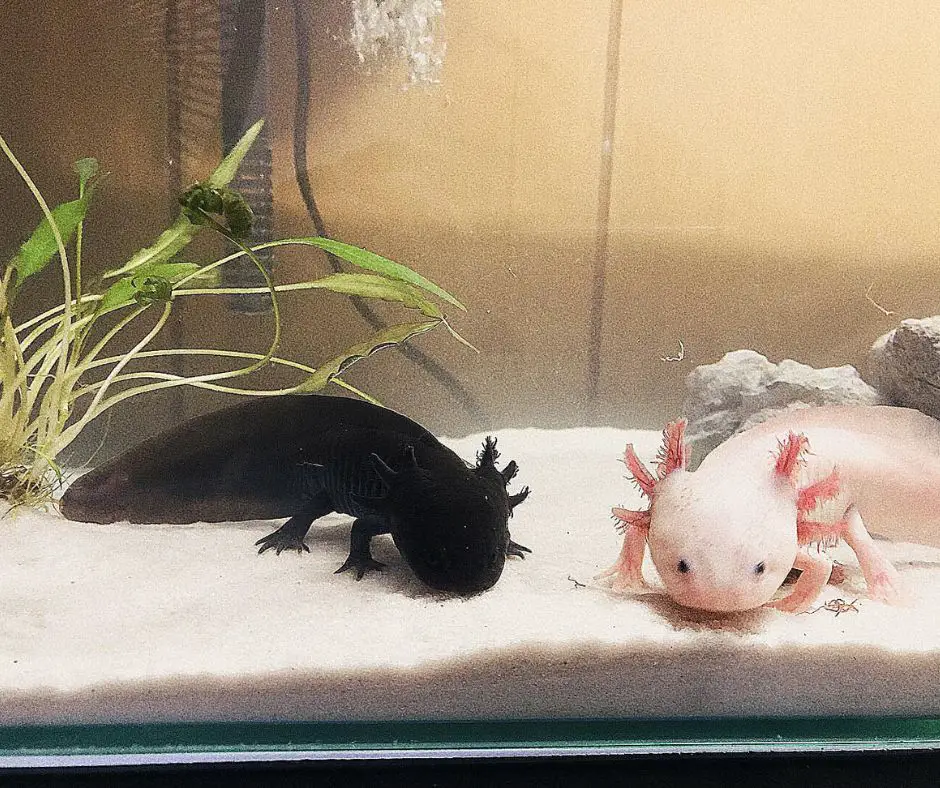
Safe for Axolotl
The most critical point to keep in mind is to choose fine, smooth sand. This way, the axolotl will not be harmed if it consumes it. As a result, safety is the primary concern in this case.
Another essential factor to note is avoiding sand that will alter the PH of the tank.
Similarly, the smoothness/fineness of the sand should be considered. Finally, the sand should not harden because this will cause filter clogging.
All-Natural
Apart from the smoothness and fineness concerns, there is also the toxicity issue to consider.
Toxin-free axolotl sand is ideal. As a result, colored sand or dyed sand is out of the question in this instance.
For instance, you may discover that black axolotl sand is not acceptable due to dyes (which can be hazardous). Otherwise, the axolotl black sand may be exceedingly fine and smooth.
However, because it contains dyes, there is a risk of toxicity, which makes it unsuitable. As a result, this is not an appropriate axolotl sand type. Naturally, the sand should also be beneficial to plants.
Select sand that can be utilized to anchor live plants and encourage them to thrive. Finally, the sand you purchase should not cloud the aquarium’s water.
Easy to Clean
Third, the sand should be simple to clean. Every owner, of course, wants a low-maintenance product, and an easy-to-clean sand substrate product falls into this category. It benefits both the axolotl and the owner.
Reasonable Expenses
The last characteristic on the list is the sand you would be buying must have a reasonable expense.
Of course, as an owner, we wouldn’t buy products that cost a fortune, but at the same time, is still high quality.
2 Best Aquarium Sand Types for Axolotl
A substrate is necessary for an axolotl’s aquarium. The issue is that there are so many different types of sand to pick from.
Sand comes in a range of shapes and sizes, and it serves a multitude of purposes. This raises the question of what kind of sand you’ll need. Which sort of axolotl tank is best?
Because of this, we decided to compile a shortlist of the best sand products for axolotl. These will suit their requirements and assist you in your journey. We’ve got the recommendations, so let’s get started!
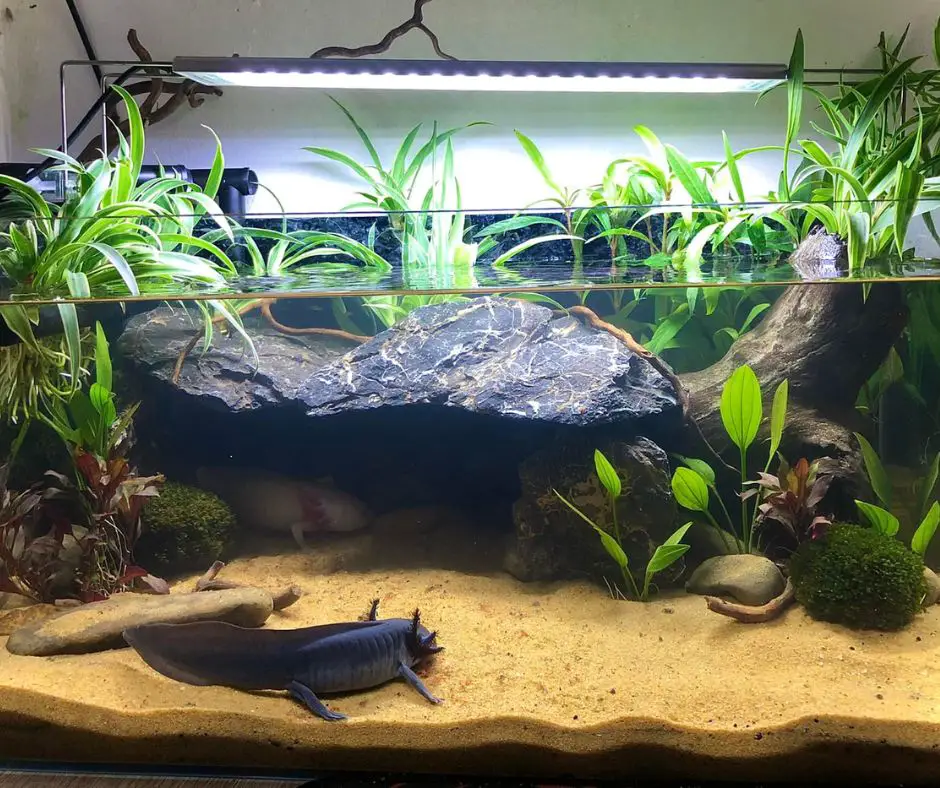
| Products | Safe for axolotl | All-Natural | Easy to Clean | Cost (around) |
| Carib Sea ACS05840 Super Naturals Crystal River Sand for Aquarium | It’s made out of soft, granular sand granules so it will not harm the Axoltol | natural substrate | This product is very easy to clean | $18.99 |
| Stoney River White Aquatic Sand Freshwater and Marine Aquariums | Formed of microscopic grains that are soft | Natural substrate | collects dirt and trash from the surface, which simplifies cleaning and maintenance. | $12.26 |
Carib Sea ACS05840 Super Naturals Crystal River Sand for Aquarium
Carib Sea Super Natural Crystal River will dramatically transform the appearance of your aquarium.
This stunning white aquarium sand is great for your Axolotl. Additionally, this substrate is compatible with most aquariums and equipment.
The CaribSea Super Naturals Aquarium Sand is a natural substrate that is one of our top picks for providing the perfect setting for your axolotl.
The best feature of this substrate is that it ensures that the pH level in your aquarium remains constant, ensuring its safety.
Additionally, the substrate is a natural product that is free of dyes and coloring agents that could be hazardous to your Axolotl.
This sand functions as a natural clarifier and conditioner, making it one of the most straightforward and low-maintenance substrates we’ve discovered.
Moreover, it does not raise water’s carbonate hardness, which is unusual for sand substrates; one less thing to worry about.
Generally, you will realize that this form of sand simplifies tank maintenance.
Because this sand is harvested straight from riverbeds, it includes a high concentration of active freshwater bacteria that will effectively filter and maintain the water quality in your aquarium.
Additionally, this sand will aid in keeping the water clear.
Finally, it reduces substrate compaction and the formation of anaerobic dead zones beneath the coral and rocks, resulting in a pleasant, healthy habitat for your Axolotl to thrive in.
This Fine-grain sand might result in hazy aquarium water, so read all directions carefully when introducing it to your tank.
This product is fantastic. Although the crystals are a bit beige and white in color, they are still quite lovely.
Washing was a little more difficult without a hose, but a couple of rinses in a bucket similar to rice washing helped. Avoid pouring the water down the drain, as sand stuck in the drain can be a problem for you!
Carib Sea ACS05840 Super Naturals Crystal River Sand for Aquarium Pros and Cons
| Pros | Cons |
| ● Offers a magical experience in the aquarium by recreating your pet’s natural environment. ● The size of the grain reduces accumulated detritus. ● All aquariums can use it because it is ph neutral. ● No paints nor dyes were used in this product | ● The water can become cloudy due to movement ● Quickly discolors |
- Create a supernatural experience by re-creating the natural world in your home
- grain size reduces built up detritus
- ph neutral ; safe for all aquariums
- no paints or dyes used
- made in the USA
Last update on 2022-12-29 / Affiliate links / Images from Amazon Product Advertising API
Stoney River White Aquatic Sand Freshwater and Marine Aquariums
There are instances when practical concerns are more important than aesthetic ones when creating an aquarium.
Nonetheless, Stoney River’s White Aquatic Sand is a wonderful option for those who want to display their aquarium in a gorgeous and pristinely white.
If you’re looking for a more cheap choice, Stoney River White sand is your best pick. It is perfect for usage in an aquarium environment because of its consistent grain quality.
Additionally, it is white, which can highlight the color of your Axolotl.
Chemically coated substrates frequently emit harmful toxins into the tank water, endangering the health of your axolotl; nevertheless, this sand is non-toxic, ensuring the health of your aquatic creatures.
Additionally, we appreciate that this product regularly balances the water in your pet’s tank, which aids in maintaining a stable pH level.
It is entirely safe to use because it does not affect the chemical balance of your tank water.
Furthermore, the gritty texture of this sand prevents it from floating across the water surface of the aquarium. With typical sand substrates, extremely abrasive particles are a common occurrence.
On the other hand, the Stoney River Water sand is formed of microscopic grains that are soft enough to provide your Axoltol with a comfortable swimming environment.
Another advantage of this substrate is its affordability. Plus, the low price does not affect the product’s quality.
Finally, this sand collects dirt and trash from the surface; simplifying cleaning and maintenance.
This sand has an extremely fine texture and is contaminant-free. The item arrived in perfect condition and is just as described and depicted.
Although the bag is small, the sand is of excellent quality. Additionally, it arrived far sooner than expected.
Stoney River White Aquatic Sand Freshwater and Marine Aquariums Pros and Cons
| Pros | Cons |
| ● Do not affect PH ● Has a non-toxic coating ● Fine Grain ● Affordable | ● May cause cloudy water |
- Will not affect PH
- Safe for use in freshwater aquariums
- Non-Toxic coating
Last update on 2022-12-29 / Affiliate links / Images from Amazon Product Advertising API
How to Clean Sand in Axolotl Tank
Cleaning aquarium sand, which becomes polluted with numerous debris, is a major task for maintaining a clean tank and a healthy axolotl.
Take note that every two weeks, your substrate should be cleaned. You can use a Siphon or a vacuum to clean the sand in your axolotl Tank.
Before sand cleaning, we recommend putting axolotl in a temporary tank. Because sand can become stuck in the axolotl’s gills, causing them to scrape.
For the sake of easier sand cleaning, you have the option of scheduling sand cleaning simultaneously with tank cleaning. This will help you save time.
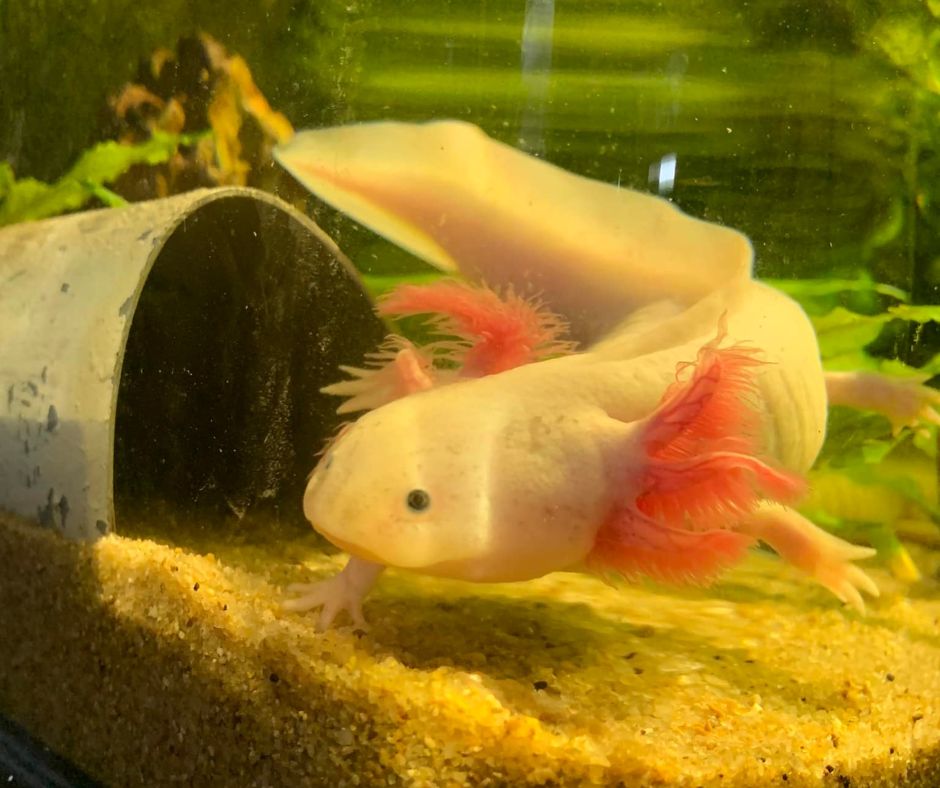
Step 1: Sand should be stirred.
Create a “lovely” cloud in the tank by thoroughly stirring the substrate. Afterward, let your tank settle for five to ten minutes. Any dirt left in the water after the filtering process will often settle on top of the sand.
Step 2: Siphon The Dirt from The Sand Surface
Once all the dirt you want to vacuum is on top of the sand, take a siphon with a huge barrel, similar to a gravel vacuum, start it, and then move over the top of the sand slowly and carefully, scooping up all the material laying on top of the sand.
Avoid getting down into the sand, as this will result in your vacuum picking up the sand substrate and removing it from the tank.
Step 3: Clean Your Filter
After cleaning up the dust and debris on top of the substrate, clean your filter as soon as possible because it will have picked up a significant amount of dirt from the water when you stirred the sand.
Note: Throw the water that contains the Wastes.
After completing Step 3, you can now dispose of the waste-containing water in your lawn or plants.
Remember that you should not flush it because the accumulated waste may still contain sand, which can clog your toilet.
Also read: 7 Best Water Filter For Axolotl
Step 4: Add New Sand
Add new sand, add all of the decorations, then place your reptilian friend back peacefully. Be gentle when placing back the axolotl, as it may take some time to adjust to the new substrate.
Best and Worst Sand for Axolotl
Substrates are the materials used to line the bottom of an axolotl’s cage.
Due to axolotls’ delicate skin and curious nature, it is critical to carefully choose a substrate. This is done to avoid damage and ingestion during the feeding process.
The greatest axolotl substrate choices and possibilities include fine smooth, natural sand, Playsand, Aquarium filter sand, pure aquarium sand without dyes, silica sand, and Estes Stoney river.
Additionally, a blend of substrates will work, but cleaning will be more challenging.
Aragonite sand and black sand are among the types of axolotl-unfriendly sand.
Additionally, sand with a sharp edge, such as construction sand, sparkling sand (crushed rock), quartz sand, marine sand (rich calcium carbonate), and reptile tank sand should be avoided.
Aragonite sand, magnetite sand, and tinted sand are some of the worst sands included as well.
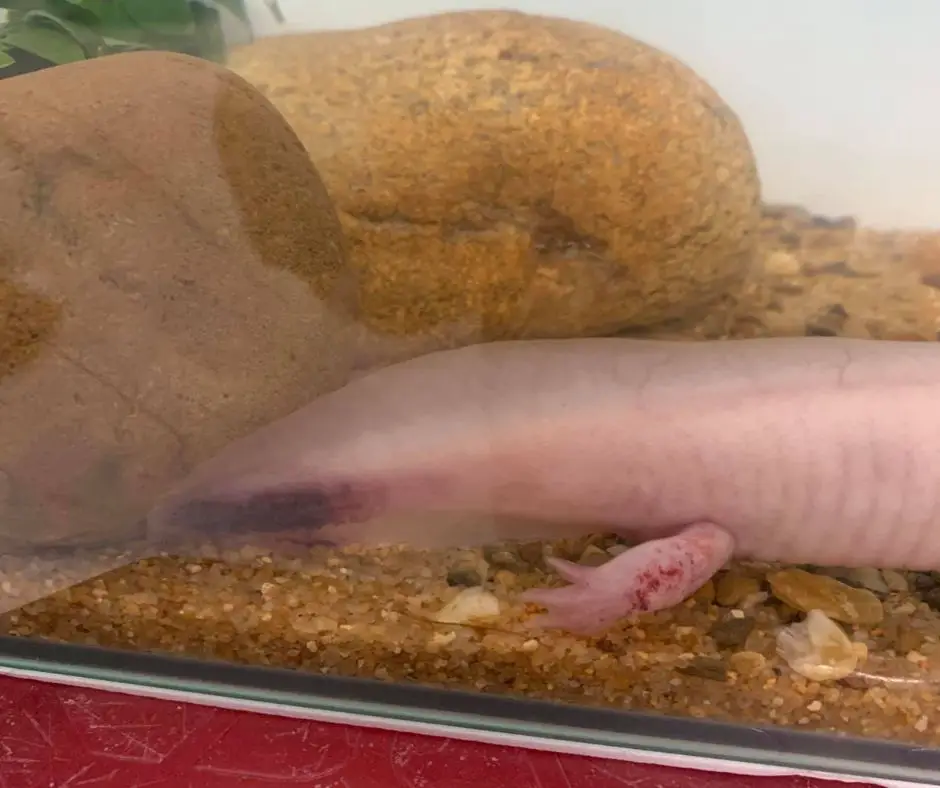
Final Verdict
In conclusion, axolotl tanks can be substrated with sand. In an axolotl aquarium, the sand used must be fine and smooth.
The axolotl’s delicate legs would be more at ease when walking on such a surface. Even if the axolotl eats it, it will not affect it.
In addition, the tank water’s PH should not be adversely affected by the sand. It should also be free of harmful substances, such as dyes.
Caribsea and Stoney River sands are two types of sand that can be used in an axolotl tank.
As a pet owner, it is your responsibility to educate yourself about pets and provide a safe and comfortable environment for your pet axolotl!
